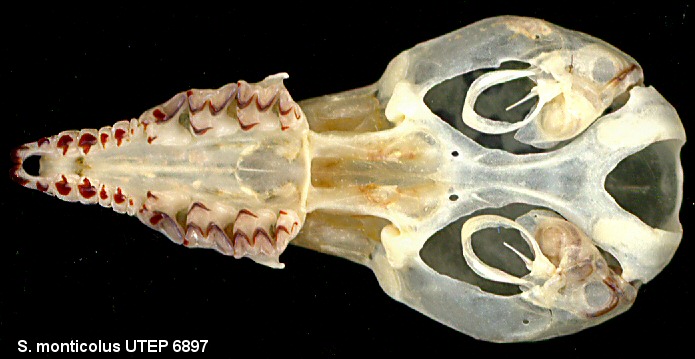1. Total teeth, 28; 3 unicuspids in each maxillary tooth-row: Notiosorex crawfordi.
1'. Total teeth more than 28; unicuspids more than 3 in each maxillary tooth-row: 2.
2. Total teeth, 30; 4 unicuspids in each maxillary tooth-row: Cryptotis parva.
2'. Total teeth, 32; 5 unicuspids in each maxillary tooth-row: (Sorex), 3
3. Third and forth unicuspids approximately equal in size: 4
3'. Third unicuspid obviously smaller than the fourth: 5
4. Each upper unicuspid tooth provided with a pigmented ridge running from apex of tooth lingually to the medial cingulum of tooth and there ending in a small pigmented cusplet; unicuspids
uncrowded, broad, and not very high-crowned; underparts brownish or buffy (not whitish): Sorex cinereus.
Ventral view of skull of Sorex monticolus showing pigmented ridges and typical characters of shrews.
4'. Each upper unicuspid without lingually directed pigmented ridge or medial cusplet; unicuspids crowded, narrow (from front to back), appearing high-crowned; underparts whitish: 7
5. Condylobasal length 20 mm or more; hindfoot fringed with stiff hairs; blackish above, white below: Sorex palustris.
5'. Condylobasal length 18 mm or less; hindfoot without fringe of stiff hairs; grayish or brownish above, tan or gray below: 6
6. Condylobasal length less than 15 mm; total length usually less than 100 mm; hindfoot 11 mm or less: Sorex nanus.
6'. Condylobasal length more than 15 mm; total length more than 100 mm; hindfoot 12 mm or more: Sorex monticolus.
7. Each upper front incisor with a small medial tine: Sorex arizonae.
7'. Upper incisor without medial tines: Sorex merriami.
Key slightly modified from Findley et al. (1975).
Last Update: 27 Jul 2005